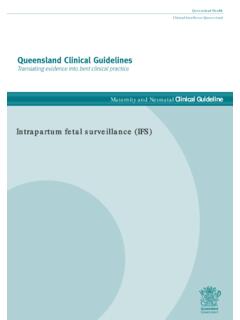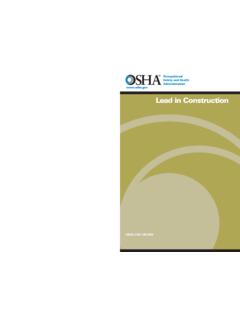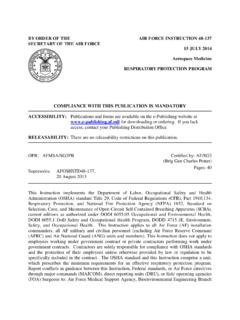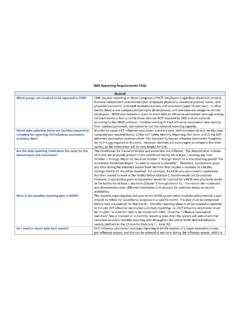Transcription of OSHA Fact Sheet: Ethylene oxide
1 What is Ethylene oxide ? Ethylene oxide (EtO) is a flammable, colorless gas at temperatures above F ( C) that smells like ether at toxic levels. EtO is found in the production of solvents, antifreeze, textiles, detergents, adhesives, polyurethane foam, and pharmaceuticals. Smaller amounts are present in fumigants, sterilants for spices and cosmetics, as well as during hospital sterilization of surgical equipment. How can Ethylene oxide harm workers? In addition to eye pain and sore throat, exposure to EtO can cause difficult breathing and blurred vision. Exposure can also cause dizziness, nausea, headache, convulsions, blisters and can result in vomiting and coughing. Both human and animal studies show that EtO is a carcinogen that may cause leukemia and other cancers.
2 EtO is also linked to spontaneous abortion, genetic damage, nerve damage, peripheral paralysis, muscle weakness, as well as impaired thinking and memory. In liquid form, EtO can cause severe skin irritation upon prolonged or confined contact. What should employers know about Ethylene oxide ? Employee exposure is limited to one part EtO per million parts of air (1 ppm) measured as an 8-hour time-weighted average (TWA). Employee exposure may not exceed the short-term excursion limit of 5 ppm EtO averaged over any 15-minute sampling period. These limits are called permissible exposure limits (PELs). Most occupational exposures to EtO are covered by the OSHA standard. The standard does not apply, however, when employers can demonstrate that the processing, use, or handling of products containing EtO will not release airborne concentrations of EtO at or above the standard s action level of ppm.
3 The action level is calculated as an 8-hour TWA and is the threshold for increased compliance activities ( , air monitoring, medical examinations, labeling, employee information, and training). For details of the requirements in OSHA s EtO standard for occupational exposures, see Title 29 of the Code of Federal Regulations (CFR) Part Note: Workplaces are exempt from this standard when objective data shows that the processing, use, or handling of products containing EtO cannot release airborne concentrations of EtO at or above the action level or in excess of the excursion limit during normal conditions. What must employers do when exposures exceed the standard s permissible exposure limits? If employee exposures exceed either the PEL or the excursion limit, employers must take the following actions: Use engineering controls and work practices to control employee exposure.
4 Establish and implement a written compliance program to reduce exposures to or below the TWA and exposure limit. Establish personal air monitoring as well as information and training programs for employees exposed to EtO at or above the action level or above the excursion limit. Conduct training upon initial job assignment and annually. Establish a regulated area wherever airborne concentrations of EtO are expected to exceed the 8-hour TWA or the excursion limit. Establish a medical surveillance program for employees exposed to EtO at concentrations above the action level of ppm, measured as an 8-hour TWA, for more than 30 days per year. Place warning labels on all containers that might cause employee exposures at or above the action level or excursion limit.
5 Remember that employee rotation is prohibited as a means of compliance with the 8-hour TWA or exposure limit. Select, provide, and maintain appropriate personal protective equipment and ensure that employees use it to prevent skin and eye contact. When must employers require workers to use respirators? Employers must ensure that workers use respirators to control EtO exposure in the following circumstances: During installation or implementation of feasible engineering controls and work practices; During maintenance, repair, and certain operations when engineering and work practice controls are not feasible; When engineering and work practice controls are not currently available to reduce exposures to or below the PEL; and During emergencies. What are employers required to do concerning exposure monitoring?
6 To help protect workers, employers must conduct the following exposure monitoring: Initial monitoring to determine the airborne concentrations of EtO that workers are exposed to (representative sampling of employees exposures is permitted). Periodic exposure monitoring if the airborne concentration of EtO is at or above the action level or above the 15-minute excursion limit. Additional monitoring if there has been a change in workplace conditions, such as a change in the process or materials used, and if the change could increase employee exposures. Note: If the exposure level is maintained below the action level, you may discontinue TWA monitoring until there is a change in production, equipment, processes, personnel, or control measures that may result in new or additional exposure to EtO.
7 Employers must also do the following: Allow affected employees or their designated representatives to observe the monitoring. Notify affected employees of the results of the monitoring within 15 working days of receiving the results. Do all businesses where EtO is present need medical surveillance programs? Employers must implement a medical surveillance program, conducted or supervised by a licensed physician, for an employee under the following circumstances: If the employee is assigned to an area where exposure to EtO may be at or above the action level for 30 days or more during the year. If the employee has been exposed to EtO in an emergency situation. What steps must employers take to communicate with workers about EtO exposure? Employers must do the following to communicate information to affected workers: Establish regulated areas where occupational exposure to EtO exceeds the 8-hr TWA or excursion limit, and clearly mark them to limit the number of workers in the regulated area and to allow only authorized persons to enter.
8 Provide the signs and labels specified by the standard clearly indicating EtO s carcinogenic and reproductive hazards in regulated areas. Train workers upon initial assignment and then annually if they are at risk of exposure at or above the action level or above the excursion limit. Maintain a material safety data sheet for EtO that conforms to the provisions of OSHA s hazard communication standard, 29 CFR (g). Are there any recordkeeping requirements concerning employee exposures to EtO? Employers are required to maintain the following records relating to employee exposure to EtO: Retain employee exposure records for 30 years. Keep employee medical records for the duration of employment plus 30 years. Keep records of objective data supporting any claimed exemption from the requirements of the OSHA standard.
9 What should employees do to protect themselves from EtO exposure? To protect against EtO exposure, follow these safety precautions: Wear goggles and skin protection at all times in areas where there is a risk of splashes from liquid EtO. Wear proper protective clothing and other approved personal protective equipment when working with EtO. Discard clothing that has been degraded by EtO. See a doctor if you are exposed to EtO. Do not eat, drink, or smoke while working with EtO. How can you get more information on safety and health? OSHA has various publications, standards, technical assistance, and compliance tools to help you, and offers extensive assistance through workplace consultation, voluntary protection programs, grants, strategic partnerships, state plans, training, and education.
10 OSHA s Safety and Health Program Management Guidelines (Federal Register 54:3904-3916, January 26, 1989) detail elements critical to the development of a successful safety and health management system. This and other information are available on OSHA s website. For one free copy of OSHA publications, send a self-addressed mailing label to OSHA Publications Office, 200 Constitution Avenue , N-3101, Washington, DC 20210; or send a request to our fax at (202) 693-2498, or call us at (202) 693-1888. To order OSHA publications online at , go to Publications and follow the instructions for ordering. To file a complaint by phone, report an emergency, or get OSHA advice, assistance, or products, contact your nearest OSHA office under the Department of Labor listing in your phone book, or call toll-free at 800) 321-OSHA (6742).
















